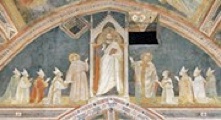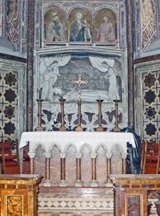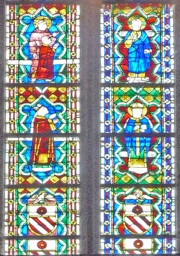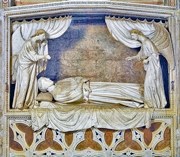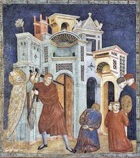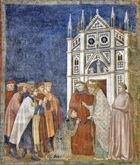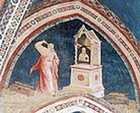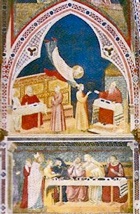Cardinal Napoleone Orsini commissioned this chapel at the end of the right transept as a burial chapel for his young brother, Giovanni Gaetano, who died during the protracted papal conclave (1292-4) at Perugia. Cardinal Jacopo Stefaneschi recorded the circumstances surrounding the death of Giovanni Gaetano in his "Opus Metricum": the shock of this event led Cardinal Orsini to settle his differences with the other cardinals participating in the conclave, and they then elected the saintly Pope Celestine V. (See the page on San Francesco in the 14th Century for the historical context).
Cardinal Orsini probably dedicated the chapel to St Nicholas of Bari in honour of his uncle, Pope Nicholas III (1277-80), who (prior to his election) was also called Giovanni Gaetano Orsini. His arms are conspicuous throughout the chapel.
In the fresco on the entrance wall the brothers are depicted being presented to Christ:
-
✴St Francis presents Cardinal Napoleone (on the left); and
-
✴St Nicholas presents Giovanni Gaetano, who is dressed as a deacon.
Three other cardinals kneel to each side.
These figures of cardinals were subsequently covered in a coat of blue paint that was removed in 1913. An investigation carried out during the restoration of 1974 suggests that there were originally eight kneeling cardinals, two of which were later covered by the figures of the Orsini brothers. This suggests that eight of the cardinals who attended the conclave in Perugia were originally associated in some way with the chapel. These cardinals may well have included (in addition to Napoleone Orsini):
-
✴Benedetto Caetani, the future Pope Boniface VIII;
-
✴Matteo d' Acquasparta;
-
✴Giacomo Colonna;
-
✴Pietro Colonna;
-
✴Latino Malabranca Orsini; and
-
✴Matteo Rosso Orsini.
It is tempting to associate the over-painting with the rift between Boniface VIII and the Colonna cardinals, which led to their excommunication in 1297. If this is the case, the chapel must have been built and decorated before that date, and the over-painting was probably carried out shortly thereafter. The chapel was first documented in 1306.
Cardinal Orsini subsequently built the Cappella di San Giovanni Battista at the opposite end of the transept as a pendant to the Cappella di San Nicolò. It seems that he originally intended it for his own funerary chapel, but it was not, in the event, used for this purpose.
Monument of Giovanni Gaetano Orsini
The monument, which forms an integral part of the decoration of the chapel, can be considered to have three components:
-
✴In the stained glass above the monument:
-
•St Francis presents Giovanni Gaetano to Christ; and
-
•Cardinal Napoleone seeks the intercession of St Nicholas, in scenes set above representations of the Orsini arms.
-
✴In the frescoed triptych in the middle register, the Madonna and Child are flanked by SS Nicholas and Francis, both of whom point to the effigy below. The figures of the Madonna and Child and of St Nicholas are very similar to those of the so-called
Badia Polyptych (ca. 1301), which is usually attributed to the workshop of Giotto (see below).
-
✴The sarcophagus and its effigy are set in draped funerary chamber that is recessed above the altar. Two tombs by
Arnolfo di Cambio probably influenced the design:
-
•The tomb of Pope Boniface VIII (1294-6), which is known only from drawings, was recessed above the altar of a shrine that was purpose-built against the inner facade of old St Peter’s, Rome.
-
•The tomb (ca. 1282) of Cardinal Guillaume de Bray in San Domenico, Orvieto, which is the earliest surviving signed work by Arnolfo di Cambio, employed deacons (rather than the angels here) to draw back the drapes of a funerary chamber that housed the effigy and sarcophagus.
In the effigy, as in the portrait on the entrance wall and in the stained glass, Giovanni Gaetano Orsini is depicted as a young deacon.
Frescoes (late 13th century)
It seems likely that the frescoes of the chapel began soon after 1294 and were completed after 1297. They are attributed to Giotto and his workshop, and seem to pre-date his work in the Arena Chapel (1305). They certainly pre-date 1307 (see below - Frescoes on the Entrance Wall). They may well have been carried out during the tenure of Brother John of Morrovalle as Minister General (i.e. in 1296-1304): Giorgio Vasari reported that it was he who called Assisi.
The frescoes in this chapel, together with those on the upper part of the outer entrance wall (i.e. the back wall of the right transept), constitute Phase I of the redecoration of the Lower Church (as defined in the page on San Francesco in the 14th Century).
Frescoes on the Inner Entrance Wall
The frescoes on the inner entrance wall (apart from the donor portraits above) depict other standing saints flanking the entrance in two registers;
-
✴SS Mary Magdalene and John the Baptist, who are shown as hermits, in the upper register; and
-
✴two unknown saints in the register below.
Scenes from the Life of St Nicholas
The scenes on the barrel vault and wall on the left depict:
-
✴St Nicholas preventing the execution of three innocent soldiers (illustrated);
-
✴a ruined fresco in which St Nicholas rescues sailors in peril;
-
✴St Nicholas appears to the Emperor Constantine in a dream to secure the release of three princes unjustly imprisoned in a cage, seen below the bed; and
-
✴two unknown saints.
The scenes on the barrel vault and wall on the right depict:
-
✴St Nicholas throws gold into a house so that the owner does not have to sell his daughters into prostitution;
-
✴a ruined fresco in which St Nicholas rescues sailors in peril;
-
✴St Nicholas forgiving the consul responsible for the above miscarriage of justice (illustrated); and
-
✴two unknown saints.
Only one fresco survives to the left, depicting an elderly Jew who relies on a statue of St Nicholas to protect his treasure attacks it when the treasure is stolen. The three frescoes below it were destroyed in 1768 by decorations put up in honour of St Joseph of Copertino (later removed).
The scene to the right depict (from the top):
-
✴St Nicholas revives a dead child;
-
✴a young slave is rescued by St Nicholas (illustrated);
-
✴the same boy is returned to his family as they celebrate the feast of St Nicholas (also illustrated); and
-
✴SS Peter and Andrew and a fair-haired Apostle.
Frescoes on the Entrance Arch
The frescoes on the under side of the entrance arch depict six pairs of saints:
-
✴on the left:
-
•SS Antony of Padua and Francis;
-
•SS Adrian (because Napoleone Orsini had been appointed as cardinal deacon of Sant’ Adriano in 1288) and George; and
-
•SS Agnes (with a lamb) and Rose; and
-
✴on the right:
-
•SS Rufinus and Nicholas of Bari;
-
•SS Sabinus and Victorinus; and
-
•SS Clare and Elizabeth of Hungary.
An inverted copy of this figure of St Clare was used in the lower left-hand corner of the Virgin and Child Enthroned with Saints (1307) by Giuliano da Rimini, which is now in the Isabella Stewart Gardner Museum, Boston.



